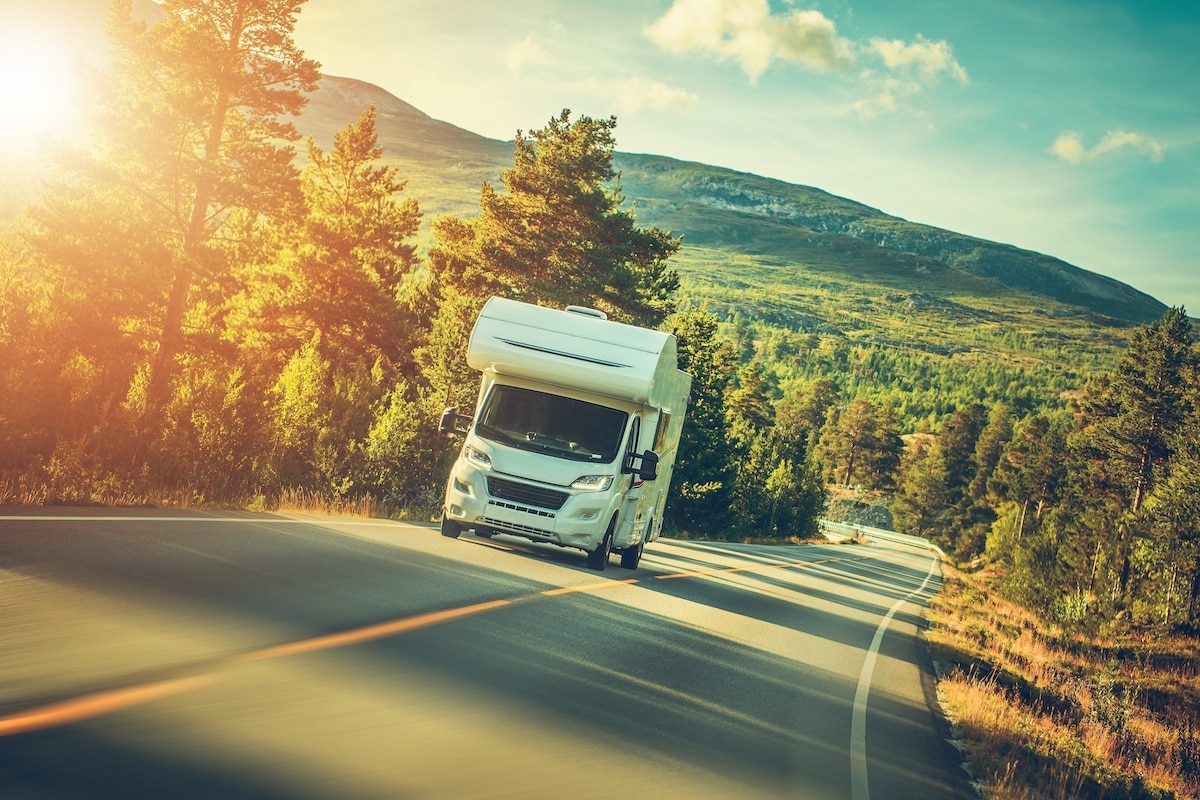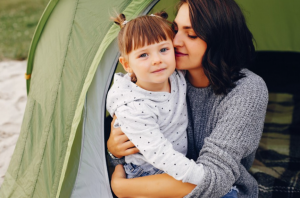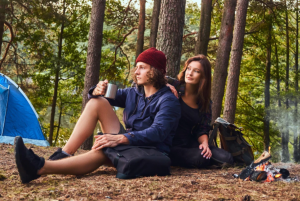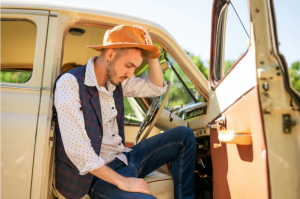You’ve made the big descision between an RV or a trailer, and it’s finally time to take your new RV out for your first camping weekend. But before you can even think about where to take it, you need to choose what you’ll be taking with you. How do you pack? What do you need to bring? I’ve collected some good tips below. Your first RV adventure is a learning experience, and this guide is here to help you from Step A to Step Z and beyond.
What We'll Cover
Packing Your RV
There’s an art to packing an RV. I’m talented at forgetting essential items (like toilet paper), so I always use a checklist. I still usually forget something, but there’s a few grocery stores on the way to our favorite RV park where I can cover any mistakes. Here are the parts of the RV you need to focus on when packing, because your local grocery store isn’t going to sell bedsheets if you forget those.
Sleeping Areas
If you’re camping overnight (which you probably will be), you need to be ready to make yourself comfy at night. Here is what you need to remember for sleeping. RV camping is a relief for a lot of people becuase you don’t have to set up a campsite, but you still need a lot of other things to make your RV comfortable.
Sheets
Our first RV had a queen-sized bed that I assumed was the same size as the queen bed in our bedroom. Not the case! The top sheet was fine, but we had to duct tape the fitted sheet to keep it from popping off. Camper beds have their own sizing guidelines. Check your regular bed sheets first (you may be luckier than I was) but give yourself time to buy RV sheets just in case. RV suppliers know the many varieties of camper beds so that the first set you buy will fit perfectly.
Most campgrounds have laundry rooms, so one spare set will probably be plenty. Young kids might need a couple of extra sets. Even if your child has passed the bedwetting stage, unfamiliar night sounds can still trigger accidents.
Pillows
The pillows you use at home are probably fine for the RV, but you may want a few support pillows, especially if you haven’t slept in the bed overnight yet. My husband’s back sometimes acts up after a long day of driving, so I pack a pillow for under his knees. I like neck pillows for extra support.
Blankets
Home blankets are fine for RV living. I pack extras for cool nights and picnics. I usually launder them right before we leave so that they smell fresh.
Sleep Accessories
Earplugs or a small fan are must-haves in a crowded or noisy campground. We rarely need them, but I pack eye-masks in case our camping site is next to an overhead light.
Kitchen
If you aren’t going to be sustaining yourselves on chips and bagged snacks, you need a stocked kitchen.
Pots and Pans
Over time, I’ve put together a separate set of pots and pans for the RV. On our first few trips, I used daily cookware from my kitchen. There’s limited space, so it helps if the pots and pans are stackable. Easy to clean pots are ideal. Dishwashing is never fun, but a quick wash-up helps. If you’re concerned about your pots and pans making noise or getting scratched while driving, cushion them with wash cloths.
Food
Planning is the key to choosing food for a camping trip. You’ll need basic condiments, snacks that don’t require any prep, and your big meal ingredients. Always plan your meals before leaving home so you can make sure you aren’t missing out on anything, like hotdog buns, which always seem to get forgotten in my household. Also, don’t forget marshmallows for s’mores after dinner!
Utensils
At minimum bring along an all-purpose knife, spatula, scissors, large spoons, large fork for turning, can/bottle/wine openers, and a strainer, which can be accomplished by purchasing a camping mess kit, a camping utensil set, and a camping knife set. I try to save space by leaving my uni-taskers at home so they don’t create clutter. On another note, while they aren’t utensils, matches or a lighter need to be somewhere on your list.
Plates and Flatware
A set of reusable (and shatter-proof) plates, bowls, and tumblers are essential. Disposable flatware is tempting, but silicon or stainless steel will last for years. Plus, it’s better for the environment. Steak knives are handy for many meals–not just steaks. If you are heading into lobster country, bring a nutcracker for the shells.
Storage Options
Aluminum foil, quart and gallon baggies, and reusable containers will cover most of your food storage needs. I also bring a large plastic dishpan that doubles as a storage container for kitchen supplies and a place to put dirty dishes.
Cleaning Supplies and Trash Bags
Microfiber cleaning rags, dish scrubbers, and biodegradable trash bags are always on my packing list. I use vinegar and baking soda as my primary cleaners just like I do at home. You’ll also need a spray bottle, toilet brush, dish soap, laundry soap, and roll of quarters for the laundry facilities. However, you can skip these if you aren’t staying long enough to warrant using the on-property laundry.
Bathroom
The restrooms on RVs are notoriously small, so I limit toiletries by getting my family to share as many things as possible. A shared bottle of shampoo and conditioner saves a lot of room compared to individual bottles for each family member. You can also share toothpaste, floss, lotion, and soap. I pack two towels (showers and swimming) for each person. You’ll also need to pack individual toothbrushes, shower shoes, sunglasses, deodorants, combs, and brushes. Don’t forget shaving supplies and feminine products.
Make a portable pharmacy with all prescriptions, first aid kit, emergency kit, insect repellant, sunscreen, Aloe Vera lotion for sunburns, anti-itch spray for insect bites (a dab of baking soda also works well), over-the-counter pain relievers, and tweezers.
Hint: Purchase plenty of biodegradable toilet paper before you get to the campground. It’s notoriously expensive at campground stores.
Living Area
Bring everything your family needs for rainy days: chargers for phones and devices, headphones, reading material, coloring and writing supplies, cards, and board games, and movies. If the weather isn’t suitable for going outdoors, you need to be prepared so no one gets too bored.
Outdoors
Hopefully, the weather will be sunny so that you can spend most of your days outdoors. For general outdoors plans, I pack water bottles, sunglasses, camping tools, sunscreen, swimsuits, Frisbees, and mountaineering tools for hiking. Night supplies include flashlights, extra batteries, camping chairs, citronella candles, a table lantern, and a camping generator to keep everything juiced up. Add in anything else your family loves like bikes, yoga mats, or kayaks and life jackets.
Finding Places to Take Your RV
There are plenty of options for camping in an RV. A reliable GPS system (or at least a good set of maps) makes the trip easier and cuts down on bickering. There are several good websites to find camps, we usually use Good Sam Club or RV Camping because they offer plenty of details and camper reviews so we know we’re going to a good campground.
Campgrounds
Campgrounds range for primitive sites designed for tent camping to luxury camps for both tents and RVs. They are usually less expensive than RV Parks. Some offer hookups, sewer, and water, but many don’t. Check the camp’s website to check for facilities, paved roads, and places to turn around. A place to turn your RV around will save you from having to back up for miles on dark roads. I usually check for pull-through RV sites too. My husband and I can both back in or out, but pull-through sites are so much more convenient.
RV Parks
RV parks are the next step up from campground. Most have full hookups for electricity, sewage, and water. Some also have cable and Wi-Fi available. Most have dumping stations on-site or nearby. Amenities range from basic camp stores and shower rooms to 18-hole golf courses and spa services. Whatever luxury level you choose, the RV community is one of the biggest draws for most travelers.
Dry Docking
Dry docking is known by many names: boondocking, dry camping, free spots, and wild camping. The basic concept is finding a free place to camp with no facilities. Usually, this is public land far off the beaten path.
Planning a boondocking trip is more involved that most RV trips. You need to bring everything into the camp with you—especially water. There likely won’t be a clean water supply, dumping station, or even a store nearby. When dry docking, you need to plan everything carefully so the trip is enjoyable.
RV Pro Tips
The RV community loves to share ideas. Aside from reading websites, take time to talk to fellow RVers at campgrounds. Or even better, attend an RV rally. Here are a few tips for common problems.
Use Bungee Cords to Keep Your Refrigerator Closed While Driving
Unless you secure them, refrigerator doors pop open when you are driving because of the road vibrations. There are fancier, more expensive solutions involving bolts and latches or specialized tension bars, but a bungee cord is all you need for most setups. Bungee cords keep cabinet doors and drawers closed too.
Use Liquid Fabric Softener or Laundry Detergent to Make the Black Water Tank Easier to Clean
The RV black tank holds collects solid and liquid waste from the toilet. It’s sometimes even called the RV waste tank. Even if you stay on top of maintenance, the black water tank is prone to smell. Fortunately, there are some easy fixes. Adding two capfuls of liquid fabric softener will often remove the smell. If not, the next thing to try is water softener and laundry detergent. Start with dissolving 2 cups (0.47 l) of water softener in a gallon of warm water. After it dissolves, stir in a cup of laundry detergent. You can also add a cup of bleach if the odor is really bad. Add the full mix to the black water tank.
Practice Driving Before Going Camping
When we purchased our first RV, the dealership offered a weekend training course. Attending was one of the best decisions we’ve ever made. The class included hooking and unhooking the trailer, basic RV maintenance, connecting the sewage lines, and hours of driving practice (highway driving, city driving, passing, backing up, etc.). Since the class was over a weekend, we drove at different times of the day under different driving conditions. I can’t say that I was completely relaxed about backing up into a campsite by the end of the weekend, but I could do it safely.
Several dealerships offer RV boot camps, but you can also find them at RV club meetups. Escape RV Club and RVing Women are good sites to start your search.
Even if you don’t go to a training camp or a safe driving class, it’s a good idea to practice driving before you leave on a big trip. An RV setup is bulky and heavy, visibility is limited, and backing up is a challenge. If you practice these skills before your vacation, you won’t have to learn with an impatient audience of kids, in-laws, or dogs.
Conclusion
Give yourself plenty of time to plan and organize before your trip, but at some point you just have to go. Forgotten items and mistakes will happen, but that’s part of the adventure. The RV community is one of the friendliest and most helpful on earth. Look for advice on the web, in campgrounds, in magazines, and at rallies. There’s always more to learn. Soon you’ll be a veteran RVer giving advice to the newbies who join the lifestyle. Go out, make friends, and have fun!
The responses below are not provided, commissioned, reviewed, approved, or otherwise endorsed by any financial entity or advertiser. It is not the advertiser’s responsibility to ensure all posts and/or questions are answered.


![Tips to Go Camping With a Toddler [Different Weather]](/assets/images/375a17532f44c72a41d33b1008823cf3.png)


